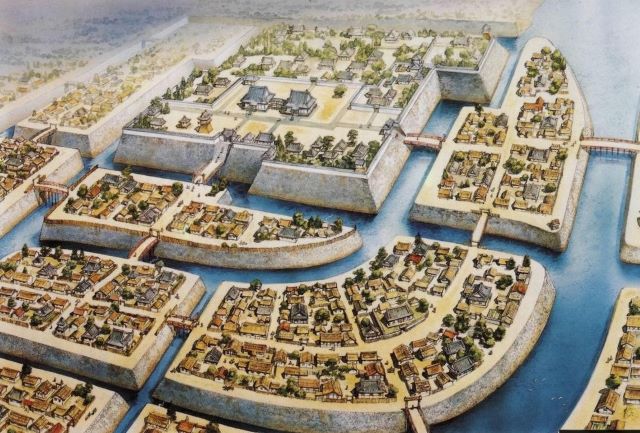In Japanese history, the siege of Ishiyama Hongan-ji — the main stronghold of the Ikkō-ikki movement during Oda Nobunaga’s campaign — is considered the longest, lasting from August 1570 to August 1580.

Initially, in 1496, the monk Rennyo (1415–1499), the ideological and spiritual leader of the Jōdo Shinshū Buddhist sect, withdrew to the mouth of the Yodo River and built a secluded hermitage on the ruins of the ancient Naniwa palace, on the "great slope" — Osaka. This modest retreat quickly grew into a large temple complex, and by 1532, after the destruction of Yamashina Mido, Ishiyama Hongan-ji had become the central fortress-monastery of the Ikkō-ikki, surrounded by the temple town (jinai-machi).
The monastery’s defenses were superbly designed: located on islands at the river’s mouth, surrounded by natural moats (channels) with bridges that could be quickly dismantled in case of attack. Defensive features included earthen ramparts (dorui) with palisades, moats (hori), Koraimon-style gates, and watchtowers. The surrounding jinai-machi acted as the outer perimeter, divided into wards by earthen walls (dobei) and moats. At the center was the island core, fortified with stone walls (ishigaki), dobei, yagura towers, and heavy yaguramon gates—closely resembling a fortified samurai castle.
Instead of a donjon, the central area housed two main halls—Amidado and Goeido—connected by a corridor. These architectural forms remain in use in modern Jōdo Shinshū temples.
The standing garrison consisted of about 100 monks, but at the toll of a bell, up to 10,000 lay followers (monto), including those from Kaga and Echizen provinces, could be summoned. The Mori clan’s navy actively supported the monastery, while Uesugi Kenshin and Takeda Shingen diverted Nobunaga’s forces in the northwest, slowing the siege.
In August 1570, Nobunaga, with a force of around 30,000, initiated the siege, surrounding the monastery with forts. In September, warrior-monks stormed the Kawaguchi and Takadono forts using 3,000 arquebusiers and coordinated volley fire.
The first years were intense, but sea routes kept the monastery supplied until 1576–1578, when Nobunaga shifted focus to maritime blockade using large ships and arquebusiers. After victories in the second Battle of Kizugawaguchi and the death of Uesugi Kenshin, Nobunaga entered the final phase: cutting off allies and capturing outer defenses.
In April 1580, abbot Kōsa (Kennyo) surrendered under imperial order, but the monastery was burned to prevent its capture. Its foundations were destroyed in August. Three years later, in 1583, Toyotomi Hideyoshi built Osaka Castle on the site.
Thus, the siege of Ishiyama Hongan-ji became the largest and longest fortress war in Japanese history, showcasing the defenders' caution and the besiegers’ persistence.
See also
-
The Siege of Hara Castle

The Shimabara Rebellion of 1637–1638, which culminated in the siege of Hara Castle, was the last major uprising of the Edo period and had serious political consequences.
-
Battle of Tennoji

The confrontation between Tokugawa Ieyasu and Toyotomi Hideyori during the “Osaka Winter Campaign” ended with the signing of a peace treaty. On January 22, 1615, the day after the treaty was signed, Ieyasu pretended to disband his army. In reality, this meant that the Shimazu forces withdrew to the nearest port. On the same day, almost the entire Tokugawa army began filling in the outer moat.
-
Siege of Shuri Castle

The Ryukyu Kingdom was established in 1429 on Okinawa, the largest island of the Ryukyu (Nansei) archipelago, as a result of the military unification of three rival kingdoms. In the following years, the state's control spread to all the islands of the archipelago.
-
The Siege of Fushimi Castle

Fushimi can perhaps be considered one of the most “unfortunate” castles of the Sengoku Jidai period. The original castle was built by Toyotomi Hideyoshi in the southeast of Kyoto in 1594 as his residence in the imperial city.
-
The Siege of Otsu Castle

The siege of Otsu Castle was part of the Sekigahara campaign, during which the so-called Eastern Coalition, led by Tokugawa Ieyasu, fought against the Western Coalition, led by Ishida Mitsunari. Otsu Castle was built in 1586 by order of Toyotomi Hideyoshi near the capital Kyoto, on the site of the dismantled Sakamoto Castle. It belonged to the type of “water castles” — mizujō — as one side of it faced Japan's largest lake, Lake Biwa, and it was surrounded by a system of moats filled with lake water, which made the fortress resemble an island.
-
The Siege of Shiroishi Castle

The siege of Shiroishi Castle was part of the Sekigahara campaign and took place several months before the decisive battle of Sekigahara. The daimyo of Aizu Province, Uesugi Kagekatsu, posed a serious threat to Tokugawa Ieyasu's plans to defeat the Western Coalition, and Ieyasu decided to curb his actions with the help of his northern vassals. To this end, he ordered Date Masamune to invade the province of Aizu and capture Shiroishi Castle.
-
The Second Siege of Jinju Castle

During the two Korean campaigns of the 16th century, the Japanese repeatedly had to capture enemy fortresses and defend occupied or constructed fortifications from the combined Korean and Chinese forces. Among all the operations of that time, the second siege of Jinju Castle is considered the most interesting from the point of view of siege warfare.
-
The Siege of Takamatsu Castle

The siege of Takamatsu Castle in Bitchu Province is considered the first mizuzeme, or “water siege,” in Japanese history. Until then, such an original tactic had never been used.

